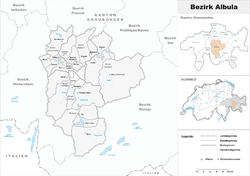Albula District
Albula District was one of the eleven administrative districts in the canton of Graubünden in Switzerland. It had an area of 723.13 km² and had a population of 8,210 in 2015. It was replaced with the Albula Region on 1 January 2017 as part of a reorganization of the Canton.[1]
Albula District Bezirk Albula District Alvra Distretto di Albula | |
|---|---|
District | |
 | |
| Country | |
| Canton | |
| Capital | Tiefencastel |
| Area | |
| • Total | 693.47 km2 (267.75 sq mi) |
| Population (2018) | |
| • Total | 8,210 |
| • Density | 12/km2 (31/sq mi) |
| Time zone | UTC+1 (CET) |
| • Summer (DST) | UTC+2 (CEST) |
| Municipalities | 8 |
Albula District consisted of four Kreise (sub-districts) Alvaschein, Belfort, Bergün and Surses, which are formed from a total of 8 municipalities following mergers in 2015 and 2016.
| Alvaschein sub-district | ||||
|---|---|---|---|---|
| Municipality | Population (31 December 2018)[2] |
Area (km²) | ||
| Albula/Alvra | 1,310 | 93.93 | ||
| Mutten | 61 | 9.9 | ||
| Vaz/Obervaz | 2,780 | 42.51 | ||
| Belfort sub-district | ||||
|---|---|---|---|---|
| Municipality | Population (31 December 2018)[2] |
Area (km²) | ||
| Lantsch/Lenz | 535 | 21.82 | ||
| Schmitten | 234 | 11.32 | ||
| Bergün sub-district | ||||
|---|---|---|---|---|
| Municipality | Population (31 December 2018)[2] |
Area (km²) | ||
| Bergün/Bravuogn | 480 | 145.76 | ||
| Filisur | 434 | 44.58 | ||
Mergers and name changes
- On 1 January 2015 the former municipalities of Alvaschein, Mon, Stierva, Tiefencastel, Alvaneu, Brienz/Brinzauls and Surava merged to form the new municipality of Albula/Alvra.[3]
- On 1 January 2016 the former municipalities of Bivio, Cunter, Marmorera, Mulegns, Riom-Parsonz, Salouf, Savognin, Sur and Tinizong-Rona merged to form the new municipality of Surses.[4]
Languages
The official languages of the district of Albula are German and Romansh. In the municipality of Bivio, Italian has given way to German as the official language there.
| Languages of Albula District, GR | ||||||
| Languages | Census 2000 | |||||
| Number | Percent | |||||
| German | 5,646 | 66.3% | ||||
| Romansh | 2,163 | 25.4% | ||||
| Italian | 263 | 3.1% | ||||
| TOTAL | 8,514 | 100% | ||||
gollark: Oh, and Minoteaur is substantially faster, sinthorionofmrasfmasf.
gollark: CNAME/A/AAAA records in their DNS panel.
gollark: Right now I don't think it offers significant *feature* improvements over mediawiki, but I have some neat ideas MW cannot practically do.
gollark: Don't use that. It makes them host HTTP for your domain and send 301 redirects to somewhere else.
gollark: - good contextual backlinks- small code base, can actually be read, also lightweight- simple Markdown support instead of horrible, *horrible* custom wikitext implementation- cooler login page- single user design
References
- Swiss Federal Statistical Office - Amtliches Gemeindeverzeichnis der Schweiz - Mutationsmeldungen 2016 accessed 16 February 2017
- Swiss Federal Statistical Office - STAT-TAB, online database – Ständige und nichtständige Wohnbevölkerung nach institutionellen Gliederungen, Geburtsort und Staatsangehörigkeit (in German) accessed 23 September 2019
- Amtliches Gemeindeverzeichnis der Schweiz published by the Swiss Federal Statistical Office (in German) accessed 2 January 2013
- Amtliches Gemeindeverzeichnis der Schweiz published by the Swiss Federal Statistical Office (in German) accessed 27 April 2016.
This article is issued from Wikipedia. The text is licensed under Creative Commons - Attribution - Sharealike. Additional terms may apply for the media files.